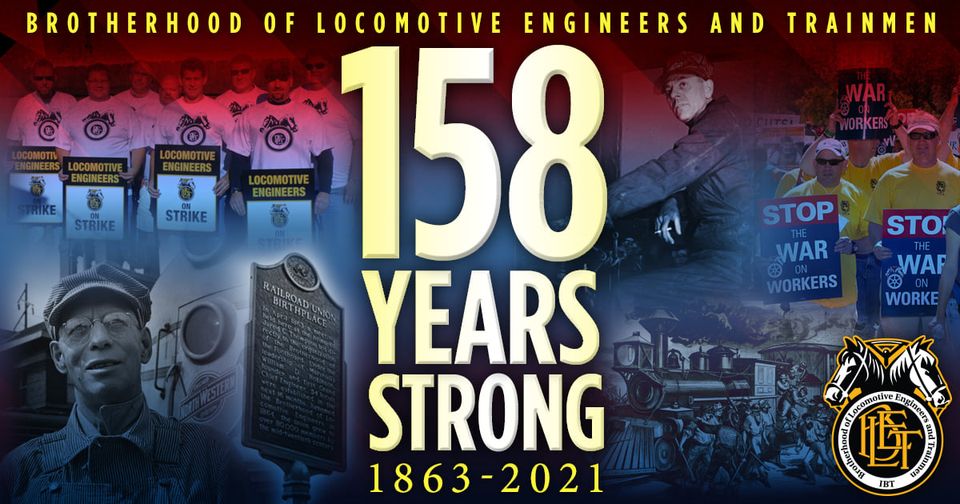Headline News
BLET Marks 158th Anniversary

On May 8, the Brotherhood of Locomotive Engineers and Trainmen (BLET) will mark its 158th anniversary. The union was founded as the Brotherhood of the Footboard on May 8, 1863. In 1864, the union changed its name to Brotherhood of Locomotive Engineers (BLE), the name it retained for 140 years until merging with the International Brotherhood of Teamsters on January 1, 2004, when it became the BLET. The BLET is the oldest labor union in the Western Hemisphere.
In the three decades before the founding of the BLET, locomotive engineers suffered abominable working conditions. The 24-hour workday was commonplace. Railroad magnates ran roughshod over employees. Strikes were mercilessly crushed.
Several attempts to organize locomotive engineers were made between 1855 and 1860. The BLET traces its roots to the early 1860s, when locomotive engineers on the Michigan Central Railroad became discouraged with pay cuts and the arbitrary dismissal of their firemen. During that time, locomotive engineers at the Michigan Central were paid at the rate of $60 a month on the condition that they ran at least 2,500 miles, regardless of the time consumed.
It wasn’t until April 1863, however, that William D. Robinson, a Michigan Central locomotive engineer, brought 19 men of the craft together at his home in Marshall, Mich., and inspired them to found the Organization, which survives today. A monument marking the event still stands in Marshall.
At a meeting in Detroit the following month, a dozen men agreed to tie their destinies together. They cemented a common bond on May 8, 1863, electing Robinson as their Grand Chief Engineer (President), and naming the group the Brotherhood of the Footboard. By August 1863, 10 Divisions had been established — Detroit and Marshall, Mich.; Michigan City, Ind.; Adrian, Mich.; Norwalk, Ohio; two in Chicago, Ill.; Lafayette, Ind.; Crestline, Ohio; and La Porte, Ind. The name Brotherhood of Locomotive Engineers (BLE) was adopted at the first national convention held in Indianapolis in August 1864.
The BLET was the first labor organization to obtain contracts with railroads. Among the earliest was an agreement with the former New York Central in 1875. Today, the BLET has hundreds of contracts with railroads large and small, and represents locomotive engineers on 98 percent of rail trackage in the United States.
The Brotherhood has always been proud to support America’s servicemen and women, and their families. Born in the midst of the Civil War, our union’s membership has been comprised of veterans of every major military conflict since, up to and including the conflicts in Iraq and Afghanistan. With BLET members at the throttle, U.S. railroads carried 90 percent of all military freight and 97 percent of all military passenger movements during World War II.
In cooperation with other railroad brotherhoods, the BLET spearheaded the drive to make the 24-hour workday illegal. This was accomplished in 1907 through the Hours of Service Act, which set a 16-hour maximum.
The Adamson Act of 1916, providing for the eight-hour day, also was as a result of the BLET’s leadership. An original copy of the Act, along with the fountain pen used by President Woodrow Wilson to sign the legislation, is displayed at BLET National Division Museum, located at the Union’s headquarters in Independence, Ohio. The Act was the first federal law dealing with overtime pay.
The BLET also played a leading role in persuading Congress to pass the Railway Labor Act in 1926. The RLA, amended several times since then, provides procedures for handling labor-management disputes over wages and working conditions.
The Railroad Retirement and Railroad Unemployment Insurance Acts, which became effective in 1937, are railroad industry’s counterparts to the Social Security system and the various state unemployment systems. They represent another instance of social progress in which the BLET played a pivotal part.
Heightened workplace safety and greater safety for the shipping and traveling public have also been important BLET goals. Legislative activities by the BLET and other rail unions have resulted in the Locomotive Inspection Act, and statutes requiring the use of air brakes, automatic couplers, electric headlights, power-reverse gears and other technological improvements.
BLET’s current National President is Dennis R. Pierce, the 23rd principal officer in the BLET’s long history. He has held the post since July 1, 2010, and is the longest serving chief executive of the Organization since 1950. The BLET is the founding member of the Teamsters Rail Conference and represents nearly 58,000 active and retired locomotive engineers and trainmen throughout the United States.
Click here to see the original article.